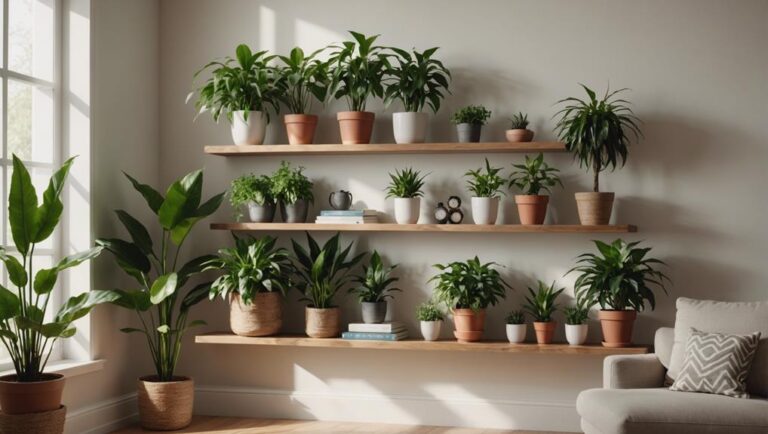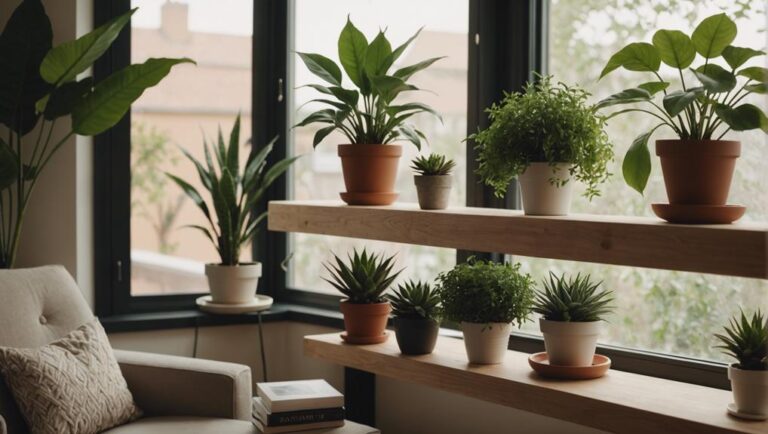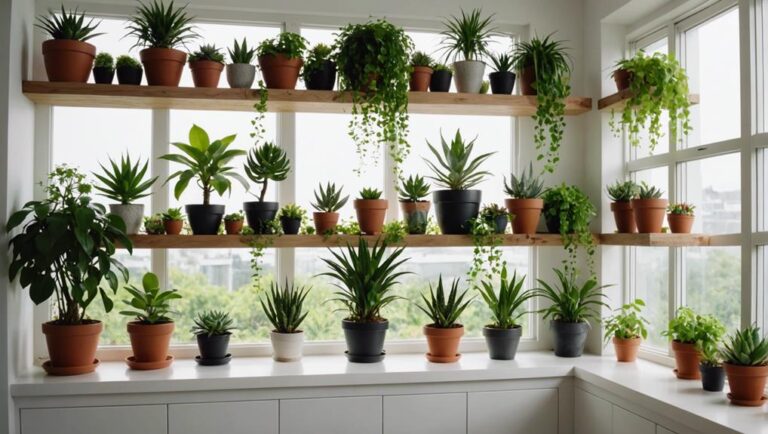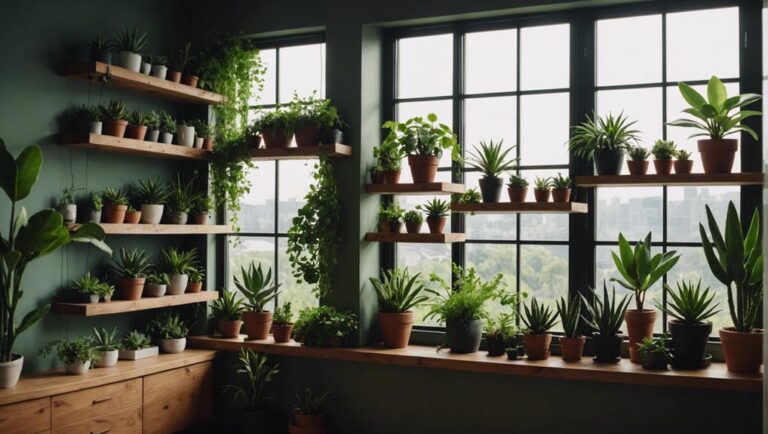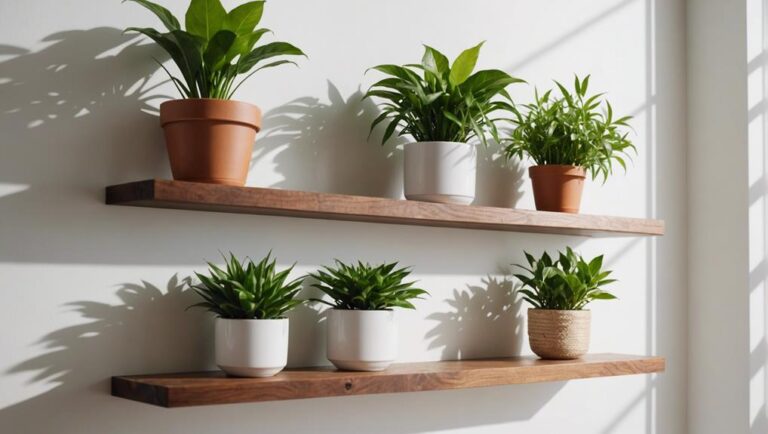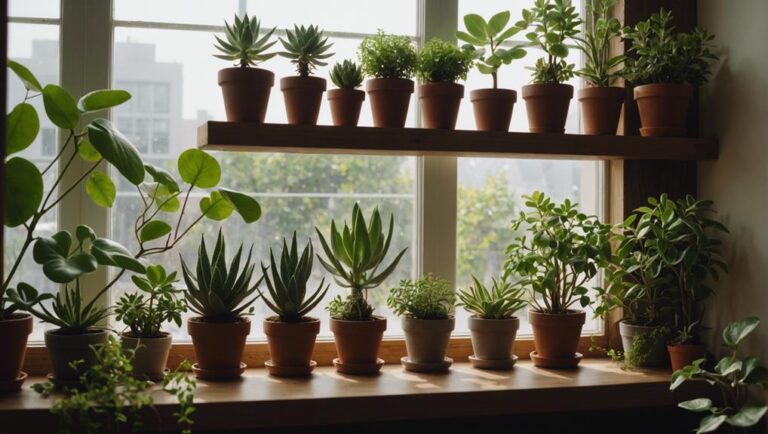Tips for Arranging Plants on Floating Wood Shelves
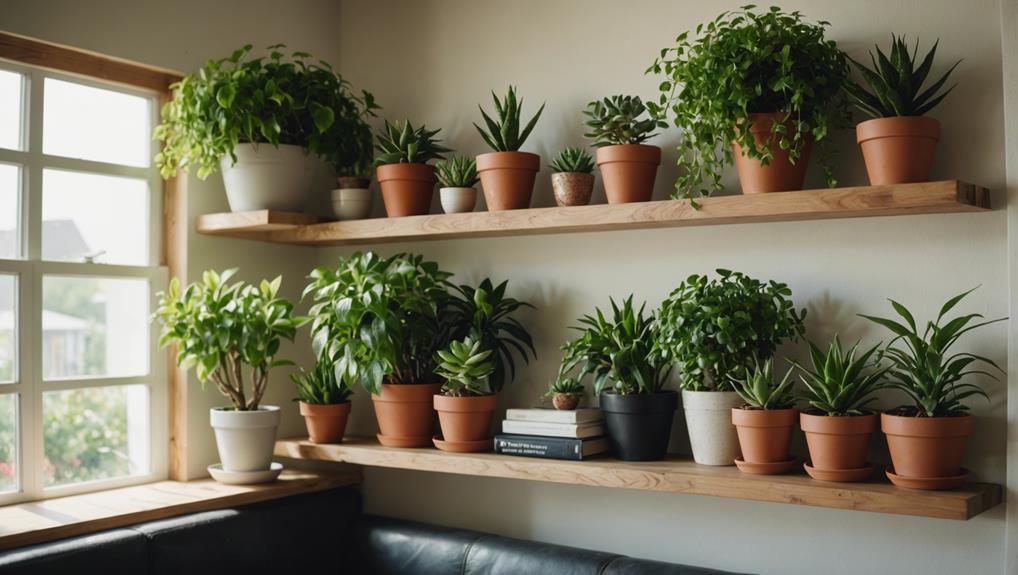
When setting up plants on floating wood shelves, it's crucial to ensure that the shelves are sturdy enough to support the weight of the plants. It's best to select a variety of plant sizes and shapes while considering their light requirements. Using drip trays is essential not only to protect the shelves from water damage but also to enhance the overall look of the display. To promote balanced growth and visual appeal, remember to rotate the plants regularly.
To create an eye-catching and cohesive plant arrangement, play around with different textures, colors, and heights. This will help in crafting a dynamic and visually interesting display that complements the room's color scheme. Consider incorporating trailing plants to add depth and dimension to the arrangement. By paying attention to these details, you can achieve a captivating and harmonious plant display on your floating wood shelves.
Key Takeaways
- Before arranging plants on your floating wood shelves, it's crucial to verify the shelf's weight capacity to ensure it can support the plants you plan to display. Be sure to distribute the weight of the plants evenly across the shelves to prevent any strain or damage.
- When selecting plants for your display, consider their light requirements. Group plants with similar light needs together to ensure they thrive in their new environment. This thoughtful grouping will not only benefit the plants but also create a visually harmonious display.
- To add visual interest and depth to your plant display, mix and match plants of varying sizes and heights. This diversity will create a dynamic and engaging arrangement that catches the eye and adds dimension to your space.
- Protect your floating wood shelves from water damage by using drip trays underneath the plants. Remember to clean these trays regularly to prevent any buildup of excess moisture that could potentially harm your shelves over time.
- To promote healthy growth and ensure all your plants receive adequate light, make it a habit to rotate them regularly. This practice will help prevent any one plant from hogging all the sunlight and encourage balanced growth throughout your display.
Assess Shelf Weight Capacity
Before organizing our plants on floating wood shelves, we must check the shelf's weight capacity to ensure safety. Knowing the weight capacity is crucial, as surpassing it could result in damage or collapse. It's important to factor in the combined weight of the plants, pots, and soil to prevent overloading and maintain the shelf's structural integrity.
Distributing the weight evenly across the shelves is key to maintaining stability and balance, reducing the risk of any part of the shelf structure becoming strained. Avoid placing heavy or large plants on a single shelf, as this could create unnecessary pressure and compromise safety.
Considering the weight capacity isn't just a safety measure; it's also about guaranteeing that our designs are both functional and visually appealing. Respecting the weight limits allows us to create stunning arrangements that reflect our unique style. Keep in mind that a well-balanced shelf not only enhances the look of the space but also ensures reliable performance.
Before proceeding to arrange our plants, let's verify those weight limits and plan our layout strategically. This way, our floating wood shelves will continue to serve as a safe and stylish focal point in our space.
Choose Suitable Plants
When picking plants for our floating wood shelves, it's crucial to prioritize those that thrive in the available light conditions to ensure they receive the appropriate amount of sunlight or shade.
Additionally, opting for plants of various sizes and shapes will help create a visually stunning arrangement.
Light Requirements
To ensure our plants thrive, let's choose species that match the lighting conditions of our space when considering Floating Wood Shelf Wall Decorative Ideas.
Understanding the light requirements of each plant is crucial for their healthy development. Succulents and cacti, for example, flourish in bright indirect light, making them perfect choices for well-lit floating shelves. On the other hand, ferns and peace lilies prefer low to moderate light, making them excellent options for areas with less light.
Grouping plants with similar light needs together simplifies care and ensures they receive the right amount of sunlight. This arrangement helps prevent issues like legginess or leaf burn that can occur due to inadequate lighting.
Here are some important points to remember:
- Bright Indirect Light: Perfect for succulents, cacti, and certain tropical plants.
- Low to Moderate Light: Ideal for ferns, peace lilies, and snake plants.
- Adjust Placement: Ensure each plant is positioned to receive optimal light exposure.
- Healthy Growth: Adequate light promotes strong growth and vibrant foliage.
Plant Size
When deciding on plant sizes for our floating wood shelves, it's crucial to maintain visual balance and functionality. The key is to select plants that fit comfortably without overcrowding the shelves. Consider the height and width of each plant to create a visually appealing arrangement that allows for growth and easy maintenance.
Incorporating a variety of small, medium, and large plants adds depth and interest to our shelves. Small ferns and succulents can fill in gaps nicely, while taller plants like snake plants can provide height and dimension. It's important to avoid plants that will quickly outgrow the shelves or necessitate frequent pruning, as this can disrupt the overall display.
Understanding the growth habits of each plant is essential to prevent overshadowing or blocking of other plants. For a creative touch, consider plants with trailing habits, such as pothos, to cascade over the edges of the shelves, adding a dynamic element to the arrangement.
Mix Plant Sizes
Having plants of different sizes on floating wood shelves can create a visually appealing and dynamic display in any room. Mixing small, medium, and large plants can turn your floating shelves into a vibrant and lively piece of art.
To create a well-balanced and interesting arrangement, vary the heights of the plants to add layers of visual interest. Place taller plants at the back of the shelf and shorter plants towards the front. Consider the growth patterns of each plant to ensure they've enough space to grow properly.
By positioning taller plants at the back and shorter plants at the front, you can create a sense of depth and make the display more engaging. This layering technique not only enhances the visual appeal but also ensures that each plant has the space it needs to thrive.
Adding a mix of textures and colors can further enhance the dynamic nature of the arrangement, making each shelf a unique focal point.
Use Drip Trays
Mixing different plant sizes can create a visually dynamic display on your floating wood shelves. However, to protect your shelves from water damage, using drip trays is essential. Drip trays capture excess water during watering, ensuring that your plant shelves remain in top condition. These trays are available in various sizes and materials, making it easy to find ones that fit your plants' dimensions and your wall shelf aesthetic.
It's crucial to choose drip trays that complement your floating wood shelves for a cohesive look. Whether you opt for sleek metal, rustic ceramic, or clear plastic trays, selecting the right ones can enhance your plant display without overshadowing it.
Remember, maintaining the cleanliness and longevity of your shelves is just as important as the beauty of your plant arrangement. To keep everything in excellent condition, make sure to regularly empty and clean your drip trays. This simple routine helps prevent mold or mildew buildup, which can be harmful to both your plants and shelves.
Rotate Plants Regularly
To maintain the vibrant display of plants on our floating wood shelves, it's essential to regularly rotate them. This simple practice ensures that each plant receives consistent light exposure, fostering robust and symmetrical growth.
Ensure Even Light Exposure
To ensure our plants receive consistent light exposure and grow symmetrically on our floating wood shelves, it's important to rotate them regularly. This practice promotes balanced development and prevents the plants from leaning towards the light source, which can lead to uneven growth and leggy stems.
By implementing a simple routine of turning our plants weekly, we can provide them with varied angles of light exposure. This helps in fostering robust and symmetrical growth over time. It's essential to observe the plants for any signs of uneven growth and adjust the rotation frequency accordingly to maintain the best light exposure.
Consistency is key in maintaining a healthy and visually appealing plant display on our floating wood shelves. By following these rotation practices, we can create an innovative and dynamic arrangement that enhances both the aesthetic appeal and the health of our plants.
Promote Healthy Growth
When we rotate our plants regularly, we ensure they receive uniform light exposure, promoting healthy growth and maintaining the aesthetic appeal of our floating wood shelf display. This simple yet effective practice prevents plants from leaning towards the light source, resulting in balanced development and a symmetrical appearance.
By rotating our plants, we also prevent overcrowding, giving each plant ample space to thrive. This strategy helps avoid leggy growth and ensures that every plant receives the necessary light and nutrients for vibrant and robust development.
The benefits of rotating plants on floating wood shelves include even light exposure, balanced development, and preventing overcrowding. These advantages contribute to a visually appealing and healthy plant display that enhances the overall decor of the space.
Experiment With Layouts
Let's get creative with the arrangement of plants on our floating wood shelves to add visual interest. Try mixing different plant heights and sizes to create a dynamic display. Experimenting with various layouts can help us discover the most appealing and functional arrangement. Grouping plants with similar care requirements together simplifies maintenance and ensures their thriving in a shared environment.
Incorporating a variety of trailing, upright, and bushy plants can make the display eye-catching. It's essential to play around with the positioning until we achieve a balanced and harmonious layout. Decorative pots or containers can also be used to introduce a vibrant splash of color and enhance the overall aesthetic of our plant arrangement.
Consider these display ideas:
- Mix and Match: Combine plants of different shapes and sizes for a visually stimulating arrangement.
- Texture Variety: Pair plants with diverse textures and foliage for a rich, layered look.
- Color Coordination: Use pots in complementing colors to boost visual appeal.
- Symmetry vs. Asymmetry: Experiment with both symmetrical and asymmetrical designs to find what aligns with your style best.
Following these suggestions will help us create a stunning and innovative plant display on our floating wood shelves, transforming them into a focal point in any space.
Vary Heights and Levels
Enhancing the visual appeal of our floating wood shelves starts with mixing up the heights and levels of the plants. This simple yet effective technique adds a touch of dynamism and charm to our display, catching the eye and bringing depth to our space. Placing taller plants at the back of the shelf creates a natural backdrop for smaller plants positioned in the front. This layering effect ensures that each plant gets its moment in the spotlight, contributing to a well-balanced and aesthetically pleasing arrangement.
To take our display to the next level, we can strategically place taller plants towards the top of the shelf and cascading or trailing plants towards the bottom. This not only maximizes the vertical space of the shelf but also introduces a sense of movement and flow into the composition.
Let's keep in mind this handy reference guide:
| Plant Height | Shelf Placement | Visual Effect |
|---|---|---|
| Tall | Back | Background |
| Medium | Middle | Fills the space |
| Short | Front | Adds foreground interest |
| Tall | Top | Utilizes height |
| Cascading | Bottom | Introduces movement |
Experimenting with different plant heights on our floating shelves will help us achieve a visually striking and innovative plant display that stands out in any room.
Balance Textures and Colors
When setting up our floating wood shelves, it's essential to consider the balance of textures and colors to create a visually appealing and cohesive plant display. Mixing different plant textures, such as smooth, fuzzy, and spiky foliage, will add depth and interest to our DIY floating shelves. This variety in textures can enhance the overall aesthetics of the arrangement and make it more engaging to the eye.
In addition to textures, balancing colors is crucial for a harmonious look. By alternating between green, variegated, and colorful foliage, we can ensure a cohesive and attractive composition on our floating wood shelves. This color variation will create a visually pleasing contrast while maintaining a sense of unity in the overall design.
To achieve this balanced and visually appealing look, it's important to consider the size and shape of each plant to prevent overcrowding on the floating wood shelves. By strategically placing plants of varying sizes and shapes, we can create a well-organized and aesthetically pleasing arrangement.
Incorporating trailing plants can also add depth and dimension to our plant display on the floating wood shelves. These cascading plants can create a sense of movement and flow, enhancing the overall visual impact of the arrangement.
Complement Your Space
When arranging plants on our floating wood shelves, it's crucial to consider the color scheme and style of our space to ensure they enhance the overall decor. By carefully selecting plants that complement our existing design elements, we can turn our shelves into a seamless part of our interior aesthetic.
To create harmony, choose plants that match the color palette of your space. For rooms with cool tones, opt for plants with deep green or bluish leaves. In contrast, warmer spaces can benefit from plants with reddish or yellowish foliage. Mixing plants of varying heights and textures adds visual interest and keeps the arrangement dynamic.
Here are some suggestions for selecting plants that will blend well with your space:
- Trailing plants are perfect for small shelves or corners, as they soften edges and add movement.
- Upright plants make great centerpieces and can be paired with shorter plants for balance.
- Bushy plants are ideal for filling gaps and creating fullness in the display.
- Succulents are excellent for minimalist decor, especially in small spaces with low light.
- Ferns thrive in shaded areas and add texture with their lush, feathery fronds.
To achieve a balanced look, arrange your plants in odd numbers and use larger plants or unique pots as focal points. Paying attention to these details will ensure that your floating wood shelves not only serve a functional purpose but also contribute to the overall aesthetic appeal of your space.
Frequently Asked Questions
How to Style Floating Shelves With Plants?
To create a captivating display on your floating wood shelves, consider mixing various sizes and types of plants for a balanced and aesthetically pleasing arrangement. Incorporating hanging planters can add a dynamic element to the overall look, while balancing larger plants with smaller ones will enhance the visual appeal of your plant display. This approach not only adds a touch of greenery to your space but also creates a functional and stylish decor element.
How Do You Layout Floating Shelves?
When setting up floating wood shelves to display plants, it's essential to consider the placement of the shelves at varying heights and distances. This approach creates a visually captivating arrangement that breaks away from traditional design norms. By experimenting with innovative and eye-catching layouts, we can achieve a dynamic and unique look that enhances the overall aesthetic of the space.
One way to create an intriguing display is to mix and match different sizes of floating wood shelves. This not only adds depth to the design but also allows for a more organic and fluid arrangement of plants. By incorporating shelves of varying lengths and widths, we can create a visually appealing composition that draws the eye and highlights the beauty of the plants on display.
Another key aspect to consider is the spacing between the floating shelves. By strategically placing the shelves at different distances from each other, we can create a sense of movement and flow within the display. This not only adds visual interest but also allows for the plants to be showcased in a way that maximizes their impact.
What Is the Rule for Floating Shelves?
When creating a floating wood shelf plant display, it is crucial to prioritize the weight capacity and opt for sturdy shelf brackets. Anchoring the shelves securely to wall studs is essential to ensure they can handle the load effectively. By following these steps, your floating shelves will not only remain stylish and innovative but will also provide a safe and sturdy platform for displaying your plants.
Can Floating Shelves Hold Plants?
Floating shelves have a weight capacity of up to 50 pounds when properly installed. This means they are more than capable of holding plants as part of a creative wall display. However, it is crucial to consider the weight of the plants and the moisture they may introduce to the shelves.
When planning a floating wood shelf plant display, it's essential to choose sturdy shelves that can support the weight of the plants without sagging or breaking. Additionally, selecting shelves with a moisture-resistant finish will help prevent any damage from watering the plants or potential water spills.
Incorporating plants on floating wood shelves can bring a touch of nature and greenery to any room. By carefully considering weight capacity and moisture resistance, you can create a beautiful and functional plant display that adds a unique aesthetic to your space.
Conclusion
To create a visually appealing and balanced display on floating wood shelves, it's crucial to consider the weight capacity of the shelves. Ensuring that the shelves can support the weight of the plants will prevent any accidents or damage.
Selecting plant species that are suitable for indoor environments and have similar care requirements is also essential for maintaining a cohesive and healthy display.
When arranging plants on floating wood shelves, mixing different sizes and shapes can add interest and depth to the overall look. Using drip trays underneath the plants won't only protect the shelves from water damage but also create a neat and organized appearance.
Regularly rotating the plants will promote even growth and ensure that all plants receive adequate sunlight.
Experimenting with different layouts and heights can help create a dynamic and visually pleasing display. By balancing textures and colors, you can enhance the overall aesthetic and create a harmonious atmosphere in your space.
Remember to complement the existing decor and style of the room to create a cohesive and inviting plant display that enhances the overall ambiance of the space.
By following these expert tips and techniques, you can cultivate a compelling, cohesive, and charming plant display on your floating wood shelves. Embrace the beauty of nature and create a horticultural haven in your home that will bring joy and tranquility to your everyday life.

